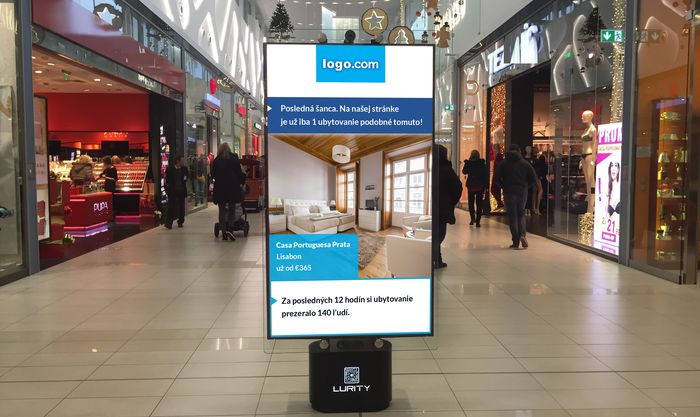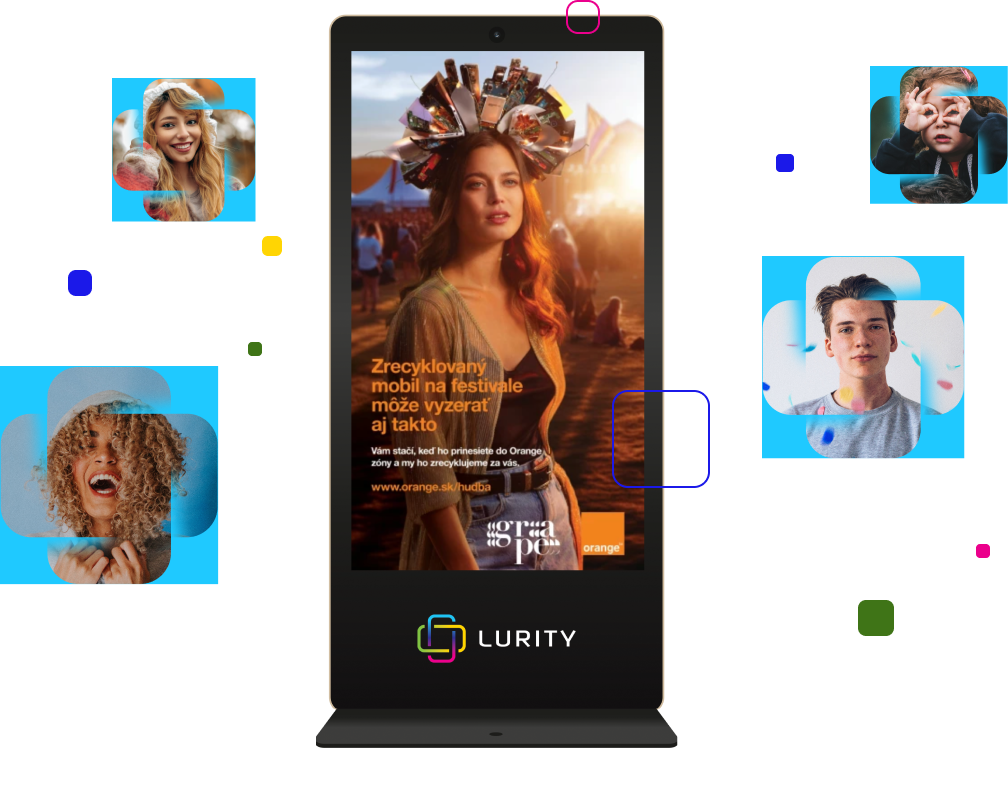Choosing an ad is a nice concern that many advertisers can't handle. The age of data brought new possibilities and visual advertising lost any boundaries. Nevertheless, many of the custom prefer a simple static form of advertising. At the same time, Dynamic opens up new possibilities for formats, media, content and ad offers. What are the differences between them and which campaign is more suitable for which one?
At the beginning, however, I must say that "dynamic advertising" in OOH (out-of-home) is not a clear concept and every marketer can imagine something different. Someone imagines a video ad under this term. Another imagines dynamically generated content similar to what Google AdWords offers. Which one is right?
We look at whether the ad is static or dynamic from the point of view of the medium, the visual and also the content.
Static Vs. dynamic formats
Static formats
These include, for example, city lights, billboards, bigboards, lightboxes in various formats and designs. Usually, the medium is paper or foil that adheres to the carrier.
The advantage is that it is the most common carrier. There are hundreds to thousands of these carriers in virtually every city. This is the biggest advantage and at the same time the curse of these carriers - they are on every corner, and that is why most people have already grown so-called "Banner blindness", similar to online banners.
The huge number of them also reduces the effectiveness of the advertising message - if 10 billboards are fighting for the attention of each other on one street, there is a low probability that passers-by will remember your advertising message. Large advertisers know this, so they try to "shout" other ads with their ads so that the ratio of their carriers to other ads increases the likelihood that passers-by will remember their ad.
Ads on these media are very difficult to target because they can't accommodate audiences or external factors. The campaigns then resemble "carpet bombing", in which advertisers try to reach as many people as possible with an untargeted offer. Namely, the probability that your target group of customers is among the addressed people is small.
Advantages:
- currently the most widespread OOH format
- ad space is yours only
Disadvantages:
- Challenging campaign preparation
- The ad must be physically pasted when the content changes
- Very poor targeting options
- does not allow personalization or dynamic content
- If the billboard does not overlay, an outdated ad will be displayed
- the threat of advertising vandalism
- very poor measurability of the intervention and overall effectiveness
- You pay for advertising even when no one is looking at it
- No backlight static ad is not visible at night
Dynamic ones
This group includes digital LCD screens (so-called digital citylights or digi-CLV) and LED boards. The difference between them is in the technology used (LCD vs LED). In principle, LCDs are better at contact distances (higher image quality) and LEDs at longer distances (larger areas and higher brightness). Due to these differences, LCDs are mainly used in indoor and LEDs, especially in outdoor environments.
These digital media are gradually coming to the fore, especially for their many advantages. One of them is, for example, that advertising content can be changed remotely at any time. This allows you to deploy not only brand campaigns to promote your brand, but also product campaigns in which the price or product description changes more often. In the case of dynamic content, digital media can automatically adapt the promoted content, for example to the state of the warehouse, and discard products that have already been sold out.
Digital media also enables video playback that is easier for the eye to register. The dynamic visual then better "engraves" into the subconscious and captures more views. The video also makes it easier to tell the story and easier to evoke emotions.
Modern digi-CLVs make it possible to measure the viewership of an advertisement via a camera. The camera can capture the views of all viewers at a certain distance, so it knows exactly how long they have been watching the ad. In addition, advanced systems can determine the age and gender of viewers based on their faces. This not only allows you to create demographic audience reports, but also target your ad to the right audience in real time.
Due to the fact that the acquisition costs for digi-CLV are many times higher than with the classic city-light, they are also more expensive when calculating the advertising space / month. However, they compensate for this shortcoming by showing the ad primarily to the target group. In addition, hyper-localized advertising can achieve many times higher sales conversions than general generic advertising. If the advertiser is able to use the full potential of these areas, the price / performance ratio is significantly on the side of digital areas.
Advantages:
- allows you to promote video spots
- the ability to change your ad immediately at virtually no cost
- modern digital surfaces can measure viewership in detail
- Smart digital desktops also enable demographic targeting
- Ability to automatically change ad content
- better contrast and luminosity of the surface will ensure visibility even from a greater distance
Disadvantages:
- less common format yet
- higher investment than with a static carrier
- You share an area with multiple advertisers
Static Vs. dynamic visual
Static visual
There is nothing behind this professional-sounding name other than image ads. Their advantage, compared to video, is very simple production. Therefore, you can relatively easily prepare a separate banner ad for each product and visually promote it.
On the other hand, static advertising makes it more difficult to attract due to the widespread "banner blindness". Static advertising must therefore be strong and share very concise information. At the same time, it is necessary to pay attention to the correct color contrast so that the text is easy to read even from a greater distance.
Equally important when deploying static advertising is the choice of the right media, given that this visual format does not offer much opportunity to stand out in the flood of advertising media. It is therefore ideal to choose a medium that is positioned in such a way that it cannot be overlooked and at the same time no other advertising media are placed around it.
Localization, dynamic content, and personalization will help increase the effectiveness of static advertising. While you can also locate with a classic billboard (for example, a poster in a specific place with the link that the store is 250 meters), the dynamic content and personalization of the paper carrier cannot. You can read about these two options in the article below.
Advantages:
- simple production
- low design price
Disadvantages:
- more challenging to engage the viewer with static advertising
- it is practically impossible to capture a story with one picture
Dynamic visual
In other words, they are video ads - animated spots or classic video spots. Video consumption is still growing, and an estimated 80 percent of advertisements are in video format.
The target group affected by dynamic advertising is also important. For example, Youtube reports that up to a third of users under the age of 44 watch at least one promotional video a day.
The clear advantage of the video is therefore the ability to quickly and easily capture the attention of the recipient. Marketing surveys show not only a significantly higher impact of dynamic advertising, but also a woefully small interest in static advertising. There is a time behind that in which we live.
the most advertising consumers use mobile devices and monitor LED or LCD monitors. The eye is thus accustomed to static points and the threshold of when it is interested in a dynamic point is constantly shifting. According to physiological studies, for the properties of the eye that transmit stimuli more intensely when it moves.
Video has another ability that static visuals can envy - it makes it easier to evoke emotions. Unlike a static image, it allows you to tell a broader story better. If the advertiser is interested in building a brand, presentation of a name or product, the dynamics allows him to explain in detail the product and its benefits. They don't even have to be demanding video formats. Sometimes an interesting compilation of still images with animations can be interesting.
Advantages:
- the moving image more easily attracts the viewer
- helps overcome banner blindness
- the ability to communicate the story
- the ability to present multiple product benefits in one video
Disadvantages:
- more demanding and expensive production than with static advertising

Static Vs. dynamic content
Static content
Simply put - whatever image you enter will be displayed during the campaign. If you run a billboard campaign, you will only make it difficult and costly to correct the visuals during its run.
Digi-CLVs allow a little more freedom even with static content - if there are changes in communication strategy or product portfolio, you can react to them. Even with modern digi-CLV, content can be targeted. For example, if an advertiser knows that a product sells better in certain weather conditions (e.g., ice cream at a temperature> 30C), you can set the visual to appear only in that weather.
Smart digi-CLVs even know how to target a product based on demographic criteria - if the product is intended primarily for women of a certain age, the product will be displayed primarily to them.
However, for static content, visuals and targeting are predetermined. So, for example, if the product you're promoting is selling out and you want to download the ad, you need to take manual action. This is also the most significant difference from dynamic content.
Advantages:
- easier setup
Disadvantages:
- changes in content must be made manually
Dynamic content
The ad is automatically generated based on external factors. The phrase "automatically generated" already precludes dynamic content from being communicated via a static medium. Not even many digi-CLVs can work with dynamic content.
One of the few OOH advertising systems that support dynamic content is LURITY. This platform supports a huge number of external factors. Here are some examples of campaigns using an external data source:
Location: an advertisement on the train which responds to the stop at which the train is currently located. In this case, efficiency is increased by the relevance of the offers.
Weather and temperature: travel agency advertisement for a stay in an exotic with the current weather in the destination. This makes it easier to differentiate yourself from other advertisers with static visuals.
Stock status: The ad will automatically pause when the product is unavailable in stock. If the communicated products are synchronized with the warehouse, this can significantly increase sales conversions.
Sports matches: brand advertising of the sponsor of the World Hockey Championship, which shows the current status of the match. In this way, a non-violent connection between the event and the brand is created.
Advantages:
- products are automatically synchronized with the web or stock
- possibility to connect with other data sources
Disadvantages:
- more demanding initial configuration
Summary
Multiple sources and marketers' experiences continue to tell a repetitive and well-known truth - if you want to promote your business comprehensively, over the long term, and among all customer groups, use multiple ad formats across many ad channels.
This is because a combination of online / offline ads that support each other works best. Based on our many experiences, we dare to say that dynamic advertising should no longer be missing in any advertising cocktail.
Photo by Joshua Earle on Unsplash
Try it effectively



